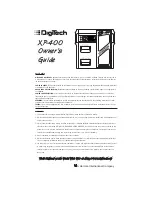
Appendix A: Functions and Instructions
851
part(
expression1
,
n
)
⇒
⇒
⇒
⇒
expression
Simplifies
expression1
and returns the
n
th
argument
or operand, where
n
is > 0 and
the number of
top-level arguments or operands returned by
part(
expression1
)
. Otherwise, an error is returned.
part(cos(
p
ù
x+3),1)
¸
3+
p
ø
x
Note:
Simplification changed the order of the
argument.
By combining the variations of
part()
, you can
extract all of the sub-expressions in the simplified
result of
expression1
. As shown in the example to
the right, you can store an argument or operand
and then use
part()
to extract further sub-
expressions.
Note:
When using
part()
, do not rely on any
particular order in sums and products.
part(cos(
p
ù
x+3))
¸
1
part(cos(
p
ù
x+3),0)
¸
"cos"
part(cos(
p
ù
x+3),1)
!
temp
¸
3+
p
ø
x
temp
¸
p
ø
x+3
part(temp,0)
¸
"+"
part(temp)
¸
2
part(temp,2)
¸
3
part(temp,1)
!
temp
¸
p
ø
x
part(temp,0)
¸
"
ù
"
part(temp)
¸
2
part(temp,1)
¸
p
part(temp,2)
¸
x
Expressions such as (x+y+z) and (x
ì
y
ì
z) are
represented internally as (x+y)+z and (x
ì
y)
ì
z.
This affects the values returned for the first and
second argument. There are technical reasons
why
part(
x+y+z,1
)
returns y+x instead of x+y.
part(x+y+z)
¸
2
part(x+y+z,2)
¸
z
part(x+y+z,1)
¸
y+x
Similarly, x
ù
y
ù
z is represented internally as
(x
ù
y)
ù
z. Again, there are technical reasons why
the first argument is returned as y
ø
x instead of
x
ø
y.
part(x
ù
y
ù
z)
¸
2
part(x
ù
y
ù
z,2)
¸
z
part(x
ù
y
ù
z,1)
¸
y
ø
x
When you extract sub-expressions from a matrix,
remember that matrices are stored as lists of lists,
as illustrated in the example to the right.
part([a,b,c;x,y,z],0)
¸
"{"
part([a,b,c;x,y,z])
¸
2
part([a,b,c;x,y,z],2)
!
temp
¸
{x y z}
part(temp,0)
¸
"{"
part(temp)
¸
3
part(temp,3)
¸
z
delVar temp
¸
Done
Summary of Contents for Voyage 200
Page 36: ...Getting Started 36 D B D B Press Result ...
Page 45: ...Getting Started 45 3 0 D B D D B D Press Result ...
Page 46: ...Getting Started 46 D 2 0 0 2 D B Scroll down to October and press Press Result ...
Page 60: ...Getting Started 60 B D Press Result ...
Page 139: ...Previews 139 8 Complete the operation Press 2 d Steps and keystrokes Display 5 f 2 ...
Page 453: ...Differential Equation Graphing 453 ...
Page 468: ...Tables 468 ...
Page 777: ...Activities 777 ...
















































